
From the earliest days of amusement parks, big name musical acts have
been a huge draw giving the crowds an opportunity to see a great show.
Whether it was John Phillip Souza and his band playing at the turn of
the 20th century to boy bands playing today, parks have hosted these
acts in an effort to draw crowds.
|
|
|
 |
| |
|
|
 |
 |
 |
| |
|
|
 |
The early months of
the season at Six Flags Great Adventure are typically a slower time of
the year with most guests waiting until the peak of summer to visit when schools
are out. To help boost attendance, the park often schedules
concerts and other special events to try and draw larger crowds. Perhaps
the best example (or worst depending on your point of view) of this
occurred in May of 1981 when Great Adventure hosted the Marshall Tucker
Band which drew crowds beyond anyone expectations.
The Marshall
Tucker Band was a pioneering "Southern Rock" band that came to
prominence in the 1970's. In 1981 the band was recovering from the
loss of one of their founding members in a car accident just over one
year before. |
 |
| |
|
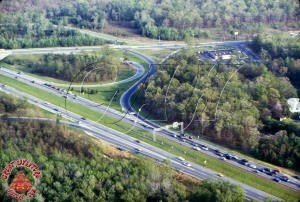 |
 |
| |
|
 |
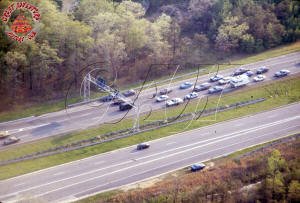 |
| |
|
|
 |
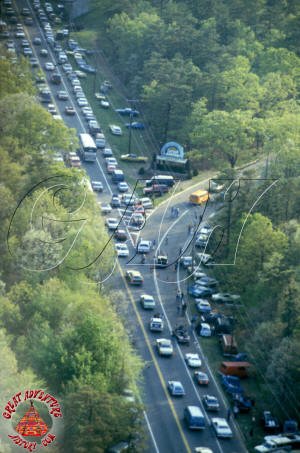 |
 |
| |
|
|
 |
Traditionally southern rock acts are not big draws in
the northeast, so rather than playing a big venue in New York City or
Philadelphia, they would often book somewhere like Great Adventure.
Quite often southern rock or country acts would draw very large crowds
to Great Adventure, being one of the only venues in the area that would
host them playing to their dedicated fans which would make the trip to the park from
miles around.
Often these acts were booked in all the Six Flags
parks and since most of the parks at the time were in the south, those
parks knew what to expect. Great Adventure was caught
off guard by just how many people would turn out for a group that most
of the staff wasn't entirely familiar with. When an act like this
was scheduled to play the park coupled with what turned out to be a great
weather day, suddenly Great Adventure went from a slow
spring weekend to a peak attendance day. |
 |
| |
 |
| |
|
 |
 |
| |
|
|
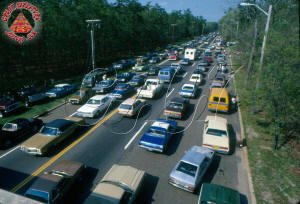 |
 |
 |
| |
|
|
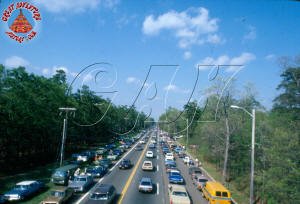 |
 |
 |
| |
|
|
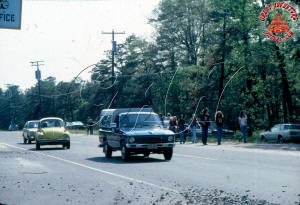 |
%20copy.jpg) |
| |
 |
| |
|
|
%20copy_small.jpg) |
May 16, 1981 turned
into the busiest day in the history of Great Adventure to that point
with the park quickly reaching capacity. Guest had to be turned away because there wasn't
anywhere left to park in their lots. Traffic quickly backed up down the
entrance road, all along Route 537, up onto I-195, and even back to
the New Jersey Turnpike. Traffic was tied up for miles with nowhere
for the cars to go. Many park goers pulled over and abandoned
their cars wherever they could find a place on the side of the road and
walked into the park.
Being
the shoulder season, the park was not up to full speed with staffing,
pushing facilities to their limits. Making matters worse, park
employees coming in for afternoon and evening shifts couldn't get to the
park and those who were there were trapped unable to leave with
the traffic jams. The local and state police came in to try and help
alleviate the situation but it took a long time to clear the lanes for traffic
trying to get past the park. |
 |
| |
|
 |
 |
| |
|
 |
 |
| |
|
|
 |
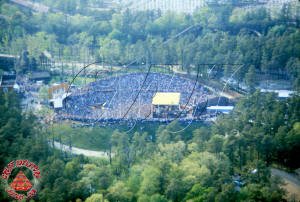 |
 |
| |
|
|
 |
The concert itself
saw the Great Arena filled beyond its capacity with the seats and floor
completely packed with guests. Many concert goers were turned away
at the Arena's gates and opted to climb the sloped grass walls of the
stadium. As a result, fencing around the base of the arena was
added shortly after this event.
With that many spectators in the Great Arena, there were bound to be
medical emergencies and the park's Security and First Aid staff
coordinating with the local and state police and local First Aid squads
took care of situations as they arose. |
 |
| |
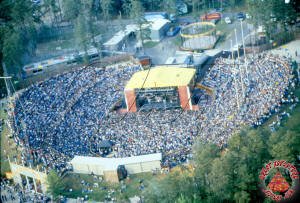 |
| |
|
|
 |
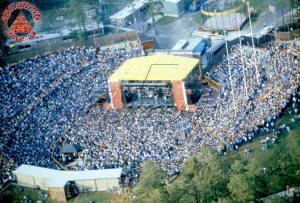 |
 |
| |
|
|
 |
The Marshall Tucker
Band concert at the Great Arena turned out to be the biggest day in Great Adventure's
history to that point, drawing more than 50,000 guests which at the time
was nearly
twice what was considered a "moderately busy" day for the park.
Since the 1981 Marshal Tucker Band Concert, Great Adventure has limited the capacity of the park to a much
more manageable number to prevent such extreme overcrowding. This
momentous event also prompted several traffic studies which developed
plans to help prevent such wide-spread traffic backups around the park. |
 |
| |
|
 |
 |
| |
|
|
 |
 |
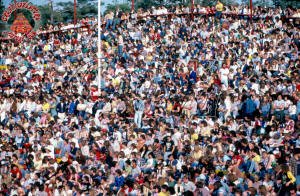 |



